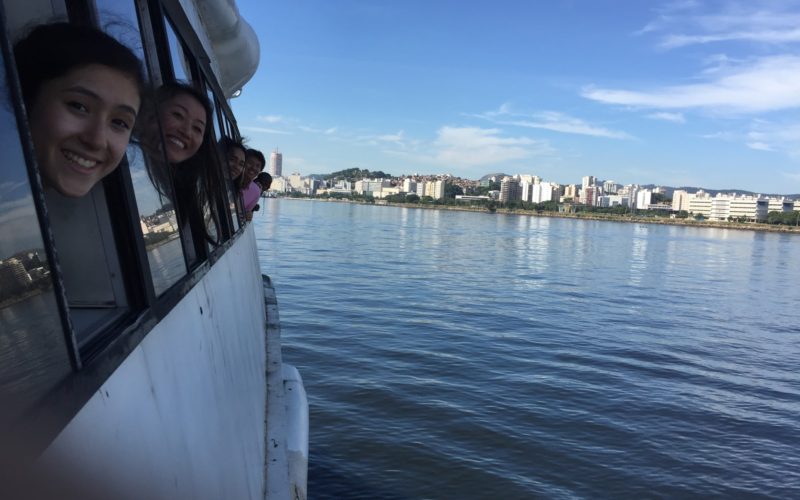Across the Guanabara Bay sits Rio de Janeiro’s sister city, Niteroi. Connected by ferries that cross the Harbor of Rio de Janeiro- which is one of the natural wonders of the world- and an 8.25 mile long concrete bridge, many of Rio’s upper and middle class workers make the journey daily, but so many tourists don’t know of its existence. It’s claim to fame is the Museu de Arte Contemporânea de Niterói or the Museum of Contemporary Art. The MAC, as it’s dubbed, is a feat of architecture: a strange, round alien saucer of a building jutting out into the bay.
My friends and I, on our only free Sunday of our month-long trip to Rio de Janeiro, decided that the ferry ride across the bay would have spectacular views and we could enjoy the MAC. We were right, and we loved hanging out of the ferry windows and seeing Rio from a new perspective: the statue of Christ the Redeemer towering over the bustling streets, tourists riding the cable car to the top of the iconic Sugar Loaf mountain, and the stretches of beaches being enjoyed by all.
 We hopped off at Niteroi and the only one of us with cell phone data plugged the museum into Maps to show us the way. We started walking from the port and disagreed about which way the directions were telling us to go, so the only one of us who spoke any Portuguese asked a nice police officer who affirmed we were going in the right direction. We kept running into him on his motorcycle, and we weren’t sure if he was trying to lead the way for us or not. After a while, he disappeared for good and we started to wonder why it was taking us so long to reach the museum. We had started walking thinking that it was a five-minute walk, and a revisit to the directions proved that it was actually a five-mile walk. Oops!
We hopped off at Niteroi and the only one of us with cell phone data plugged the museum into Maps to show us the way. We started walking from the port and disagreed about which way the directions were telling us to go, so the only one of us who spoke any Portuguese asked a nice police officer who affirmed we were going in the right direction. We kept running into him on his motorcycle, and we weren’t sure if he was trying to lead the way for us or not. After a while, he disappeared for good and we started to wonder why it was taking us so long to reach the museum. We had started walking thinking that it was a five-minute walk, and a revisit to the directions proved that it was actually a five-mile walk. Oops!
We decided to keep going, following the winding pathway along the coast until we got to the museum, despite the distance being much more than our sundresses and flip flops could handle. We walked past a government installation, small seaside pubs, locals fishing off of the high stone wall to out right, straight into the bay. We stopped to purchase frozen mango ‘popsicles’ from a nice old man wheeling around a cooler. We wound up and up and back down and down, following the coast wherever it took us, knowing that eventually we will reach our destination. A few of us bought fresh coconuts from a small shop and we drank as we walked.
“Ugh this is taking forever.”
“Should we just get an Uber?”
“Check the map again. How much longer?”
If we had let the walk get the better of us, or had given up, we would’ve missed the spectacular views, the popsicles, the coconuts, the fishermen. We even came across a statue of a Portuguese colonizer that had been spray painted over to showcase Zumbi dos Palmares, an important black warrior in Brazilian history who resisted slavery. One of the classes we were taking was about racial history, so it was a symbol that we understood to mean resistance against racism in contemporary Brazil.
If we had given up, we never would have seen it. We never would have experienced Niteroi on a different level. Never would have gone to that little beach or gotten Brazilian sushi for lunch. The museum was interesting and beautiful, but there is so much more to places than the typical destination. I’ll always be glad we misread the map and made the trek through Niteroi, and although the blisters on my feet took a while to heal, it was a good lesson that going with the flow can give you the best experiences.

